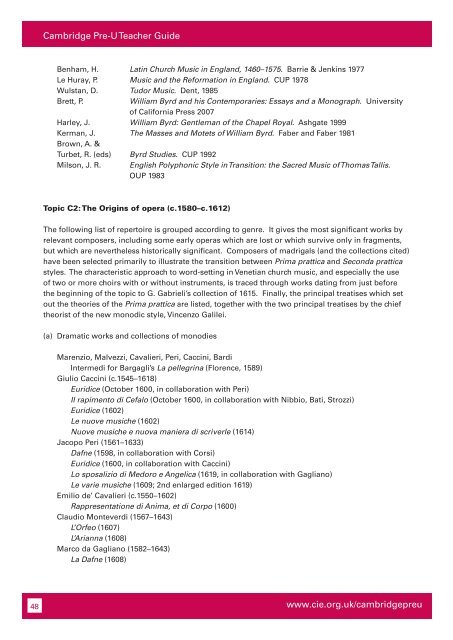Teacher's Guide Cambridge Pre-U MUSIC Available for teaching ...
Teacher's Guide Cambridge Pre-U MUSIC Available for teaching ...
Teacher's Guide Cambridge Pre-U MUSIC Available for teaching ...
You also want an ePaper? Increase the reach of your titles
YUMPU automatically turns print PDFs into web optimized ePapers that Google loves.
48<br />
<strong>Cambridge</strong> <strong>Pre</strong>-U Teacher <strong>Guide</strong><br />
Benham, H. Latin Church Music in England, 1460–1575. Barrie & Jenkins 1977<br />
Le Huray, P. Music and the Re<strong>for</strong>mation in England. CUP 1978<br />
Wulstan, D. Tudor Music. Dent, 1985<br />
Brett, P. William Byrd and his Contemporaries: Essays and a Monograph. University<br />
of Cali<strong>for</strong>nia <strong>Pre</strong>ss 2007<br />
Harley, J. William Byrd: Gentleman of the Chapel Royal. Ashgate 1999<br />
Kerman, J. The Masses and Motets of William Byrd. Faber and Faber 1981<br />
Brown, A. &<br />
Turbet, R. (eds) Byrd Studies. CUP 1992<br />
Milson, J. R. English Polyphonic Style in Transition: the Sacred Music of Thomas Tallis.<br />
OUP 1983<br />
Topic C2: The Origins of opera (c.1580–c.1612)<br />
The following list of repertoire is grouped according to genre. It gives the most significant works by<br />
relevant composers, including some early operas which are lost or which survive only in fragments,<br />
but which are nevertheless historically significant. Composers of madrigals (and the collections cited)<br />
have been selected primarily to illustrate the transition between Prima prattica and Seconda prattica<br />
styles. The characteristic approach to word-setting in Venetian church music, and especially the use<br />
of two or more choirs with or without instruments, is traced through works dating from just be<strong>for</strong>e<br />
the beginning of the topic to G. Gabrieli’s collection of 1615. Finally, the principal treatises which set<br />
out the theories of the Prima prattica are listed, together with the two principal treatises by the chief<br />
theorist of the new monodic style, Vincenzo Galilei.<br />
(a) Dramatic works and collections of monodies<br />
Marenzio, Malvezzi, Cavalieri, Peri, Caccini, Bardi<br />
Intermedi <strong>for</strong> Bargagli’s La pellegrina (Florence, 1589)<br />
Giulio Caccini (c.1545–1618)<br />
Euridice (October 1600, in collaboration with Peri)<br />
Il rapimento di Cefalo (October 1600, in collaboration with Nibbio, Bati, Strozzi)<br />
Euridice (1602)<br />
Le nuove musiche (1602)<br />
Nuove musiche e nuova maniera di scriverle (1614)<br />
Jacopo Peri (1561–1633)<br />
Dafne (1598, in collaboration with Corsi)<br />
Euridice (1600, in collaboration with Caccini)<br />
Lo sposalizio di Medoro e Angelica (1619, in collaboration with Gagliano)<br />
Le varie musiche (1609; 2nd enlarged edition 1619)<br />
Emilio de’ Cavalieri (c.1550–1602)<br />
Rappresentatione di Anima, et di Corpo (1600)<br />
Claudio Monteverdi (1567–1643)<br />
L’Orfeo (1607)<br />
L’Arianna (1608)<br />
Marco da Gagliano (1582–1643)<br />
La Dafne (1608)<br />
www.cie.org.uk/cambridgepreu
















